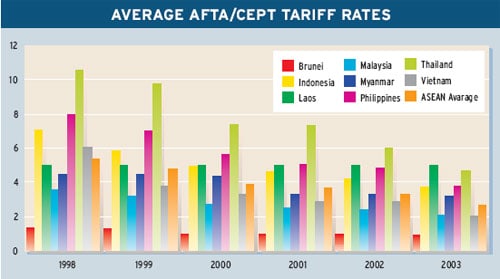Asean Countries Find Joy in Unity
South East Asias regional trade alliance is looking for ways to promote intra-regional cooperation without reducing its members competitiveness.

|
The driving force behind free trade agreements is usually the idea that free trade promotes higher levels of economic integration and cooperation between regions. In reality, however, free trade agreements (FTAs) are often difficult and time consuming to implement, and there are questions around who really benefits from them.
Opponents often claim it is the larger developed countries with more sophisticated and powerful industrial conglomerates while supporters assert that it is the developing countries looking to make it onto the first rung of the ladder in their bid to become global market-based economies. The 2002 trade dispute over the United States imposition of tariffs on steel imports in an effort to stem local job losses is a reminder that countries are only willing to open their markets so far and that the political will needs to exist for FTAs to be faithfully applied.
Implementing FTAs may be challenging, but they are considered to deliver clear economic benefits for those countries that can make them work. Studies by the Centre for Economic Policy Research show regional free trade deals between EU countries, for example, or the US, Canada and Mexico (NAFTA) can boost trade and economic growth. In the EU, consultant McKinsey says less-developed countries such as Ireland, Portugal and Spain gained more from EU membership in terms of higher levels of economic growth. Similarly, studies indicate that Mexicos economic growth has accelerated since it joined NAFTA.
ASEAN countries have been watching other regions progress with interest. Now, the six original signatories, Brunei, Indonesia, Malaysia, the Philippines, Thailand and Singapore, and the newer entrants, Cambodia, Laos, Vietnam and Myanmar, are hoping to emulate their success. Combined, the 10 member countries constitute a market of 500 million people with a combined GDP of $600 billion, the largest Asian consumer market in terms of value outside of China. In addition, ASEAN is also home to 40% of the Asia-Pacifics oil and gas resources.
|
Caught Napping |
|
ASEAN came into being in 1967 as a means of promoting peace, progress and economic prosperity across the region. At its fourth summit in Singapore, in 1992, the ASEAN Free Trade Area (AFTA) was born, with the aim of promoting the gradual phasing out of regional trade tariffs. The agreement has since been extended to include elimination of non-tariff barriers, liberalization of trade in services and intra-regional cooperation on intellectual property rights.
But almost 40 years after the birth of ASEAN, the global economic landscape is much altered. Low-cost manufacturing centers in China and India have emerged, which means ASEAN can no longer compete on labor costs alone. In addition, the region is still reeling from the economic crisis of 1997, which, says McKinsey, caused FDI to fall by 66% and aggregate economic growth to decline by 50%. According to the ASEAN Surveillance Co-ordination Unit, from 1996 to 2002 the former Asian tiger economies average annual growth of GDP was 1.8%, compared to 7.8% for China. Exports grew at an annual average rate of 1.5% in the tiger economies, compared to 13.1% in China. While China surges ahead, ASEAN has been caught napping. In terms of increasing productivity, reducing costs across the region and increasing foreign investment, Adam Schwarz and Roland Villinger, consultants in McKinseys Bangkok and Singapore offices, believe that further trade liberalization and regional economic integration is needed. ASEAN must find the political will to reduce further the tariffs and non-tariff barriers that raise the cost of doing business across the regions borders, Schwarz and Villinger reported. |
Free Flowing

|
|
|
ASEAN has not been resting on its laurels, though. Since the 1997 crisis, the original six AFTA signatories agreed to speed up tariff reduction. At Phnom Penh in September 2003, the AFTA Council announced that, after a decade, AFTA had been virtually realized, with regional tariffs on 99.6% of products in the Common Effective Preferential Tariff (CEPT) Inclusion List in the ASEAN-6 countries being reduced to within the 0%-5% range.
Only 247 tariff lines within the region remained outside the remit of CEPT. The Council also announced that uptake of CEPT in the newer ASEAN member countries (Vietnam, Cambodia, Laos and Myanmar) was keeping pace with the original members, with inclusion lists comprising 72.22% of the total number of tariffs, compared to 64.27% in 2002. More than 60% of products they traded within the region were within the 0%-5% tariff band. The target for all ASEAN-6 countries to reduce tariffs on imports to zero is 2010. The newer ASEAN countries have until 2015.
A number of ASEAN countries have also instigated FTAs with countries outside the region, notably Australia, China, South Korea, Japan and the United States. In November 2002 ASEAN signed a Comprehensive Economic Co-operation Framework Agreement with China, which focuses on liberalization of trade, services and investment, as well as economic cooperation. Japan is also looking to secure an economic partnership agreement with the ASEAN countries, which includes an FTA.
The framework agreement with China also includes an ASEAN-China FTA (ACFTA), which seeks to reduce both normal and sensitive tariffs, with different implementation schedules set for the ASEAN-6 and the newer countries. By January 2007 the ASEAN-6 and China hope to have reduced 60% of normal tariffs to 0%-5%. However, 150 tariff lines could still be in place by 2010, and reduction of tariff lines on the sensitive list may not occur until 2018 or 2020 for the newer ASEAN countries.
|
Working Together |
|
In addition to liberalizing trade, in 1997 ASEAN outlined its Vision 2020 for achieving closer economic integration and narrowing the gap in development between countries such as Singapore and Thailand and Cambodia and Laos. In a recent paper on the evolution of ASEAN FTAs, Hadi Soesastro, executive director and senior economist at the Center for Strategic and International Studies (CSIS) in Jakarta, stated, [ASEANs plans] to deepen economic integration amongst its 10 members is a major undertaking in view of the big differences in levels of economic development and openness.
The ASEAN group of countries realize that if they want to attract outside investment, they need to put aside their competitive differences and work together. Foreign investors increasingly see ASEAN as a single market and production base, says Martin Hutagalung, manager, ASEAN/APEC affairs, at the US-ASEAN Business Council, based in Washington. It is quite challenging though, he adds, pointing to the newer ASEAN countries such as Laos, Cambodia and Vietnam, which are still in the initial throes of becoming market-based, outwardly focused economies. Everybody wants ASEAN to get in the game and not be left behind. The ASEAN signatories have to find a way to help the four newest member countries develop, says Hutagalung. But can all countries within ASEAN equally benefit from free trade? Joseph Tan, an economist with Standard Chartered Bank in Singapore, believes that to get to that stage, various countries have to have the same pace of economic development, and in this sense Singapore and Thailand are further up the scale than countries like Vietnam and Cambodia, which are struggling to be on an even footing, he says. Although FTAs may have helped goodsand to some extent services and investmentto flow more freely, ASEAN still does more trade with countries outside the region. Although intra-regional trade may have increased since 1992, when AFTA was first implemented, McKinsey says from 1994 to 2001 intra-regional trade within ASEAN countries as a proportion of total trade fell by 19%. Some estimates put ASEANs trade with other ASEAN countries at 23%, compared to 62% of EU trade, which is intra-EU. |
Protectionism Persists
Although 99% of tariffs on the inclusion list in the ASEAN-6 countries are at relatively low levels, some countries still exercise protectionist policies when it comes to sensitive products. Malaysia, for instance, continues to protect its domestic auto industry manufacturer Proton from foreign competition by imposing tariffs on imports (see Malaysia Focus, page 40), and the Philippines continues to stand firm on its imposition of tariffs on rice imports, which it has exempted from full-scale liberalization.
Masahiro Kawai, economic adviser to Asian Development Bank president Haruhiko Kuroda, stresses that while most countries within ASEAN realize they must liberalize trade, some have weak spots in their economies. Take the EU and agriculture, he says. Not all countries, even developed ones, liberalize completely. Most of the [ASEAN] countries have weak spots, but they agree that they are going to liberalize. Malaysia may still protect its automotive industry, but Hutagalung says it has agreed to lower tariffs to between 0% and 5% by 2010.
One of the biggest criticisms of ASEAN is that, as it is a government-led trade group that works on the basis of consensus, it has neither the power nor the resources to effectively coordinate and monitor implementation and compliance across the 10 countries. The ASEAN Secretariat is unable to push for the common goal of 2010, says Tan, as they dont have the political or financial muscle to push through these developments.
Many tariffs have been lowered, but other non-tariff areas still need to be tackled, including the lack of standardized customs procedures across the ASEAN. Efficiencies could be gained from harmonizing product and technical regulations and testing and licensing procedures. Some industry associations are also concerned about the pace at which countries are working to liberalize certain areas.
The Malaysian Plastic Manufacturers Association, for example, has called for the total elimination of tariffs on resin earlier than the 2010 deadline. Soesastro of CSIS in Jakarta says it is in the interests of ASEAN and China to try to accelerate the ACFTA process, but, he adds, the political will has to be there for this to happen. He says ACFTA is only the first step in what could be a protracted process, as negotiations around liberalizing services and investment could prove tricky.
Despite higher levels of economic cooperation across the region, ASEAN remains a collection of disparate markets. The flow of goods may be freer, but as Tan points out, the lack of free mobility for labor and capital still makes it difficult for foreign investors to do business in the region. There are a lot more hidden costs of doing business in a region as diverse as ASEAN, he says. Hutagalung sounds a more optimistic note, saying that if the political will is there, ASEANs 2020 vision can be realized.
But for a true single market to be realized within ASEAN, along the lines of the EU, for example, Kawai of the ADB says the ASEAN countries need to attain similar levels of economic development, including income, standard of living and market infrastructure and institutions, something that does not exist today, although he is heartened by economic growth inherent in Vietnam and Cambodias entry into the WTO. Low-income countries are catching up, he says, but a single common market like the EU may be difficult in the short run. And although trade, FDI and macroeconomic interdependence are driving economic integration across the region, Kawai says this has not filtered down to the institutional level. Institutional harmonization and integration is the next step, he says, and FTAs are one important instrument for achieving that.
Anita Hawser




